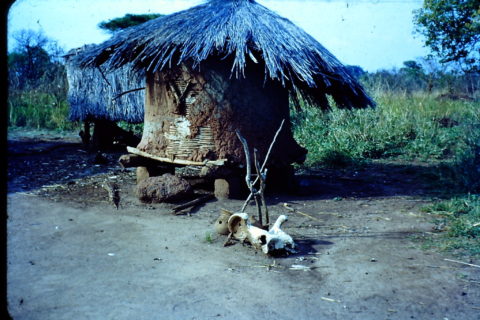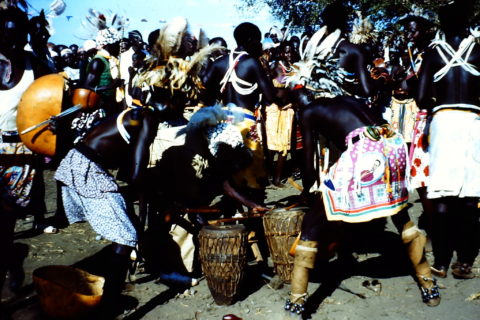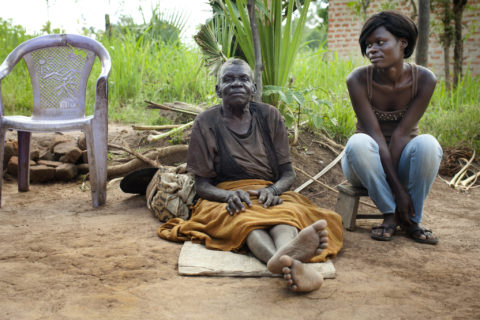Article begins
Among Acholis, ideals of home and a good life are resilient even if everyday realities increasingly diverge from such aspirations.
There is a tendency to think about love as something private—an intimate matter between two people. But as a friend once told me, “You cannot understand Acholi love if you think that it is between two people.” If she is right, and I think she is, then our understanding of the phenomenon of love should consider the wider societal backdrop as well as the particular web of social relations in which lovers find themselves. In northern Uganda—where I have spent most of my time since 2005—this means the contexts of war, displacement, and subsequent “return.”

An ancestral shrine or abila. Paula Hirsch Foster collection, Boston University African Studies Library
The two-decade long war (1986–2006) in northern Uganda entailed profound disruptions to “normal” orderings of life. Alongside violence and the mass displacement of over 90 percent of the Acholi population, there was an influx of nongovernmental organizations, foreigners, radio talk shows, micro-credit and income-generating opportunities often geared toward women, and devastating impoverishment. People had limited if any access to land and cattle, with the former greatly structuring everyday activities of gendered life and the latter the basis for negotiating kinship relations. Formal marriage practices were nearly impossible under the conditions in displacement camps. Yet, in the midst and the aftermath of war people continue to fall in love, to have intimate encounters, produce children, and begin homes.
War is, of course, a massively disruptive force and many things related to sex, love, and intimate relationships are impacted. Yet, perhaps what is most surprising is how much seems the same. In the aftermath of war gendered ideals of intimate relationships are resilient, even if everyday realities are increasingly divergent from such aspirations. This opens a complex space where sexual desires and aspirations mix, creating angst, contestation, and some newfound freedoms.
The meaning of life?
Paula Hirsh Foster, an anthropologist who did fieldwork in the Acholi subregion in the mid-1950s writes of the Acholi that the “supreme meaning of life lies in the perpetuation of one’s own name in the lineage. This means fame, prestige, and power for those individuals who have many children and opposite for those who have not” (Paula Hirsch Foster Collection 1954–1958). Those who have a spouse and at least one child are considered full persons, as having “a head,” while those who lack either or both are not. I gave a copy of her nearly completed thesis to one of my Acholi former medical anthropology students. When we met to discuss it, he had picked up on this argument and wanted to interrogate it. I smiled, “So you want to know the supreme meaning of life?” My young friend was not convinced that having children and perpetuating one’s lineage was so central—it did not resonate with him at least. But, as he admits, he is what many Acholi now jokingly term “Acholi B.” “And perhaps, the perpetuation of the lineage is still the supreme meaning of life for Acholi A,” he mused.
In the midst of the aftermath of war people continue to fall in love, to have intimate encounters, produce children, and begin homes.

An archival photograph of an Acholi dance. Paula Hirsch Foster collection, Boston University African Studies Library
The variant Acholi lifeworlds signified by “A” and “B” were also evident in the diverse responses to ancestral shrines, or abila, that I encountered last year in fieldwork and in the Foster archives. Abila have power over the productivity of the lineage. Although alienated from ancestral land during displacement, I heard of many women who preserved umbilical cords for decades in the camp, anticipating their placement beneath the re-established abila once they were able to return. Much as the war is often represented as a total rupture in Acholi ways of life, these women’s actions exemplify sustained attending to material that would lead to social reproduction in years to come. These stories stood in contrast to others, in which people had decided to prayerfully destroy their abila because the ancestors were sabotaging their love lives and fertility—effectively betraying their duties to perpetuate the lineage.
Coming back to my young friend’s questioning of Foster’s observation, a popular answer the world over to “the supreme meaning of life,” and part of his own answer as well—is love.
In 1964, Acholi anthropologist, poet, and playwright Okot p’Bitek wrote that Acholi love is “certainly not a kind of pond into which the lovers fall together.” P’Bitek, not unlike many of my informants over the years and many of their predecessors interacting with Western anthropologists of the past, tended to minimize and even distrust the influence of “love” understood as romantic love (Thomas 2009). Yet affections are undeniably evident through observations of passions, jealousies, attraction, and caring over time. In his essay entitled “Acholi Love” (1964), p’Bitek describes an archetypal courtship and the emotional content of a relationship as mit: want, desire. He then goes on to devote a good portion of the essay to “the problems of a childless marriage” demonstrating the centrality of reproduction to Acholi love lives. Unmarried people, or those who do not participate in childbirth are problematic to the ideal notion of a homestead or home, which is premised on a division of labor and social relations that entail marriage and children.
Taking a cue from p’Bitek and Foster perhaps (or of course?) love and the perpetuation of the lineage are interlinked; one does tend to lead to the other. But what of love and relationships in the particular context of displacement and its aftermath? How do experiences of war reshape constructions of “home”? Which, ultimately, I have found is much of what the pursuit of love is about in the Acholi context—a project of establishing and maintaining a home. Looking at love and desire offers a window into what a good and happy life looks like.
Two love songs
“Beautiful Lady in My Heart” (“Pilaber tye I cwinya”), is a common number in the repertoire of Acholi traditional dance music, referred to as lakubukubu. The song is a public proclamation of love—but not primarily to the girl: “My people my own, I have found a beauty, my wife my own. My people, happiness is killing me,” a man sings. The song is directed to his kin in his repeated refrain, “my people.” At the end, he addresses his mother six times, emphasizing that the girl is kwiri, a word that combines the admirable qualities of being energetic, industrious, hardworking, creative, and clever. He recognizes that his chosen wife is not only for himself. He admires her overwhelming beauty: “My people, her neck is like that of a crested crane. She has a big buttock—if you are to see it!” he exclaims repeatedly, but she is not for him alone. He is convincing his people, especially his mother that she is a woman worthy of joining the family. “She has grown like a true Acholi girl,” he says, asserting her proper upbringing, and proclaims how “lucky” she is to join his praiseworthy home (gang deyo). His love for her is intertwined with the project of creating home.
The idea and ideals of home are also central to a second currently popular song entitled, “You Just Arrived in Town Today.” A village girl with archetypal Acholi propriety has caught the attention of the musician, Antoni, in a town disco.
Musicians, and other town-dwelling youth who might attend a disco, would widely be referred to as Acholi B. The singer describes the young woman’s unfashionable dress: she is “wearing a ready-made dress,” and “yellow plastic shoes”—she is obviously Acholi A. In her appearance and subsequent behavior she exudes the village and the ideals of home: “girl the way I see you, you’ve just arrived today,” he swoons through every chorus. And in this he expresses a pervasive longing for an imagined timeless ideal of Acholi life. It manifests in the desire for intimacy with a girl in the most “modern” of settings.

A woman who relocated to town because of her experience during the war visits her grandmother in the village. Anne Ackermann
Why does this girl find herself there? Antoni might reason—as I have heard many young men in town do—that she is after money and an easy life. But she proves that the promise of financial gain is insufficient to win her attention. She is approached by “a famous Indian businessman” who says she looks like “hot piri piri” and offers to buy her things and “take care of her for free.” Ideals of Acholi love, and particularly of “providing” masculine love, are heavily laden with expectations of materiality—and yet importantly, they are not singularly material (Hunter 2010; Thomas and Cole 2009). Customary exchanges, the promise of provision, and the buying of drinks or gifts, are expressions of and constitutive of social and intimate bonds. If they are not, when such exchanges occur emptied of their moral and social content, they are widely judged negatively. She shows this by proclaiming the man “very stupid,” then references her place in a web of kinship: “Does he think he can seduce me—the grandchild of Faludina?!” Rejecting the Indian man’s advances, she asserts propriety and conformance with the social imperative for Acholi girls to play hard to get (p’Bitek 1964; Porter 2017).
After the young woman sits and refuses to dance through American singer Jason Derulo’s song “Wiggle,” then “jumps out of her seat” and revels in the dance of more homegrown beats (Lingala), followed by some flirtatious banter (reminiscent of p’Bitek’s archetypal love debate), Antoni eventually asks where her home is. This is significant. With this question he signals his seriousness; he recognizes that she is connected to a home and if his relationship to her progresses it will need to go beyond the disco hall. Her response includes a comical description: “Follow the route that goes to Keyo then you turn left…If you come across a ripe papaya tree, turn…” Undoubtedly, Acholi listeners smile, as in this she also indicates temporality: the fruit should be ripe when he goes looking for her home.
Antoni offers to buy her a succession of treats (beer, soda, chewing gum) all of which she rejects as “stupid” and asks instead for a common village sweet, “bingo.” “So what will you drink?” he persists. And she replies, “You buy for me superdeep,” a cheap syrupy orange-flavoured drink. At first blush, this seems an almost childlike request. Perhaps not. “Come and I whisper to you,” she says. If we imagine pulsing beats, with lips possibly brushing his ear to be heard over the music, uttered in near darkness, “superdeep” suddenly sounds much more suggestive, and the message is not lost on him: “Waiter, bring one crate of ‘super deep’—I mean one 10-liter jerry can!” The desire is palpable and infused with imaginaries that predate war.
Reflections
One begins to think that these are familiar-sounding stories, or perhaps not so dissimilar to other places (see Parikh 2015 for an example of love lives elsewhere in Uganda). The question we might ask is what difference it makes that a war took place here? We cannot know, of course, how love and the practices around it might have evolved in its absence. We do know that the spatial dimensions of regulating romance—and hence kinship practices—were unsettled by the war. We know that there are currently different cultural influences and that the exposure to these was accelerated by circumstances of war, particularly the rapid “urbanization” of displacement. We know that young people were exposed earlier to the sexual practices of adults than they likely would have been had they not needed to share huts with their parents beyond the proscribed age. We know that young men experience the customary payments to legitimize their sexual relationships and marry as prohibitively costly and receive proportionally less support from kin than in the past.
We also know that the well-trodden paths of beginning a sexual relationship, establishing a new home, and acquiring the blessing of ancestors on one’s offspring were nearly impossible to follow for several decades during the war. Consequently, many thousands of relationships began and pregnancies occurred which do not conform to the imagined ideals of Acholi A life.
The war thus may have given birth to Acholi B (though they likely would have emerged in some form eventually). But even in a disco—a focal point of their social lives—there appears an umbilical cord that continues to feed notions of what a good life in Acholi looks like, tied to imaginations of the past, preserved through years of upheaval, and brought out again as new homes are established and couples and their kin confront the challenges of life—holding in tension contested ideals and social reproduction as these play out in their love lives.
Holly Porter is a Marie Skłodowska-Curie Fellow at the University of Antwerp and Ghent University and research fellow in the Firoz Lalji Centre for Africa at the London School of Economics. She is the author of many articles and 2018 finalist for the Hersksovits Prize for After Rape: Violence, Justice, and Social Harmony in Uganda (2017).
Cite as: Porter, Holly. 2019. “Love and the Pursuit of Home after War.” Anthropology News website, January 25, 2019. DOI: 10.1111/AN.1073

